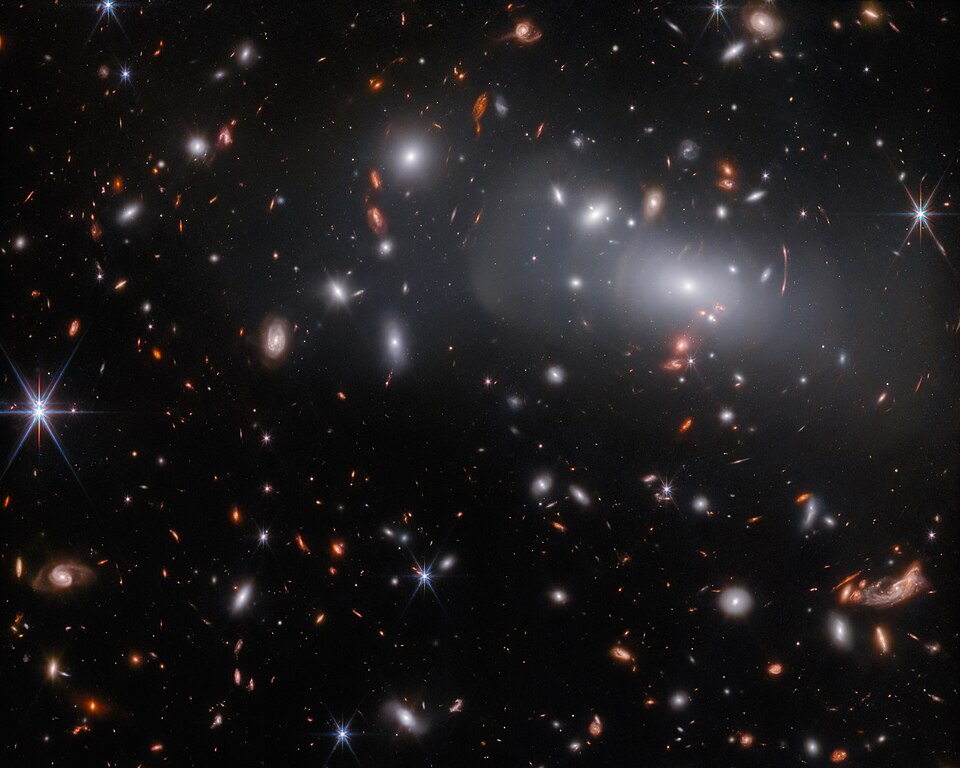Galaxy Evolution and Clusters
Several astronomy faculty members work in the broad area of observational extragalactic astrophysics, working on overlapping and complementary aspects of the field. This covers the physics and evolution of galaxies, the larger structures that they inhabit and the active galactic nuclei that a subset of them contain. The field is a significant driver of research in astrophysics worldwide.

Galaxies
Our work covers understanding how galaxies and their constituent matter behave and evolve through cosmic time, by studying their morphologies, environment, stellar populations, gas and dust content through multi-wavelength observations.
Galaxies grow and change as the Universe evolves over time. By looking at higher and higher redshift, we construct a picture of how the first galaxies formed and how they have evolved into the diverse systems we see in the local Universe. We study these systems over a wide range of wavelengths to probe different physical processes, and build a comprehensive picture of their stellar, molecular gas and dust content. Having previously carried out pioneering work on the discovery and study of galaxies seen 1-2 billion years after the Big Bang, we are now exploring how galaxies such as these evolve in the subsequent several billion years, and how this evolution is affected by their environment.
Galaxy Clusters
Our work on galaxy clusters is also multi-wavelength in nature. Clusters of galaxies are massive cosmic structures containing hundreds to thousands of galaxies. In addition to the galaxies, clusters also contain hot, X-ray-emitting plasma, as well as dark matter. We study cluster formation and evolution, as well as the complex feedback between the galaxies, their AGN, and the X-ray plasma. Much of this work is done as part of major international collaborations performing optical and X-ray surveys to discover new, distant, clusters of galaxies, or studying known clusters of galaxies in exquisite detail.
Clusters of galaxies can be used as powerful cosmological probes with which we can measure the fundamental properties of our Universe. We are refining techniques for determining accurate masses of galaxy clusters, including the invisible dark matter, crucial for effective determination of cosmological paramters. Coupled with multi-wavelength observations, including X-ray observations of the hot plasma and optical observations of gravitational lensing, we use advanced statistical techniques to model large samples of galaxy clusters to investigate how astrophysical processes alter their properties. We also develop new statistical techniques to detect galaxy clusters in large, multi-wavelength survey datasets.
There is substantial overlap between our work on galaxies and our work on galaxy clusters. Galaxy properties like star formation rate and morphology are strongly influenced by their local environment, with clusters having the most extreme effect. Using high resolution optical and near-IR imaging, we can explore how galaxies in and around clusters are affected as a function of cosmological time. In turn, observations of increasingly high-redshift galaxies allow us to identify the proto-cluster progenitors of local clusters.
Links to Active Galaxies and Black Holes
We carry out surveys to identify AGN over a large fraction of the universe's history by, for example, cross-correlating X-ray and optical images to detect galaxies that contain strong X-ray emission from their centres, commensurate with emission from AGN. These studies are about to be revolutionised with the data coming from the Euclid space mission, which provides optical and near-IR imaging at spatial resolution similar to that of HST over a huge fraction of the sky. These data will allow us to identify the most complete and reliable samples of AGN, ready for detailed follow-up studies to determine how these AGN trace the broader galaxy population. As it is thought that the powerful emission from AGN is responsible for regulating the star formation in their host galaxies, a clear picture of the diversity of the population and their hosts are key to understanding in detail the role of feedback from AGN in the evolution of the universe and the galaxies it contains.
Links to Observational Astrophysics
All of the above work requires access to world-leading observing facilities. We carry out projects that use multiple telescopes, both ground and space-based, at the cutting edge of modern astronomy. Much of the optical and near-IR work uses ESO's Very Large Telescope in Chile and data from HST. The radio observations use data from a variety of telescopes around the world, most notably MeerKAT, an array of telescopes situated in South Africa, which is a precursor to the Square Kilometre Array. The latter is being developed to be the pre-eminent radio telescope in the world and Bristol astronomer's involvement with MeerKAT place them in a strong position to exploit this revolutionary telescope that will be operational in the next few years. We have extensively used ESA's XMM-Newton and NASA's Chandra X-ray telescopes for cluster and AGN work, and members of the group are involved in developing the science specifications for NewAthena, the next generation ESA X-ray mission. Several of us are members of the Euclid consortium, carrying out the unprecedented optical and near-IR survey of the extragalactic sky with ESA's Euclid mission which will deliver key data across all of our scientific interests outlined in this page. We are a member of LSST-UK, the UK collaboration which will use the Vera Rubin Observatory and its LSST survey to carry out a huge range of astrophysics. Its photometry and imaging will be crucial to furthering our science, particularly when combined with data from other facilities like Euclid, where the photometric sensitivity of LSST and the spatial resolution of Euclid will revolutionise our ability to characterise and understand the evolution of galaxies and galaxy clusters.
